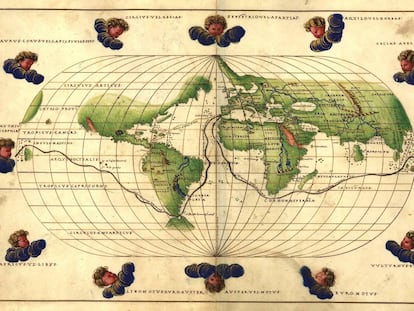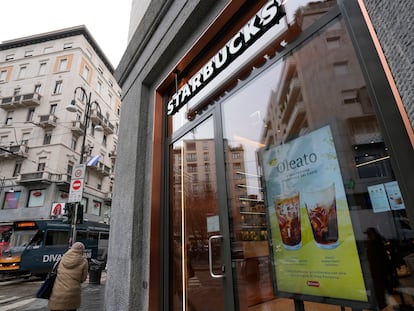The first trip around the world, or how olive oil marked globalization
A study reveals the influence of the olive trade between the New and Old Worlds. Magellan’s expedition had six thousand liters in the holds of its ships


The five ships in the first round-the-world expedition (San Antonio, Trinidad, Concepción, Victoria and Santiago), commanded by Ferdinand Magellan, departed from Seville in August 1519. In their holds they stored 475 arrobas (5,966 liters) of olive oil worth a total price of 58,425 maravedís, plus another 4,925 maravedís for the value of the jars, according to the records kept in the General Archive of the Indies in Seville, Spain.
According to the naval historian Vicente Ruiz García, “olive oil became the ingredient that best represented the culinary fusion between the so-called New and Old Worlds, and a reference for what we call early globalization.” Ruiz, who is an advisor to the Chair of History and Naval Heritage at the University of Murcia, is the author of the book El mar, el aceite de oliva y la primera globalización (in English: The sea, olive oil and the first globalization), a tribute to all the men who suffered many hardships in a feat that is key to understanding world trade.
Both the first voyage of Christopher Columbus and the one led by Magellan had as their main goal finding a route to the Moluccas (an archipelago in modern-day Indonesia) in search of much sought-after spices, which were used to preserve food. “But after traveling thousands of miles and even completing a trip around the world, it is paradoxical to say the least that all that time they’d been carrying one of the best food preservatives on board: olive oil,” explains Ruiz, a doctor in History and secretary of the distance university UNED who is based in Jaén, a province in southern Spain that is the largest producer of olive oil in the world.
The power of olive oil as a food preservative had been known since ancient times. The first European civilizations that used oil — preferably olive oil — for this function were the Etruscans, the Greeks and the Romans. The reason is the high content in polyphenols and vitamin E, which isolates food and prevents its contact with microorganisms.
Magellan’s ships crossed the autumnal equinox in the Southern Hemisphere, sailing off the coast of Argentina. Only 10 days later they would drop anchor in the Port of San Julián to spend the winter there. Meanwhile, on March 21, 1520, very far from there, officials of the Casa de Contratación of Seville paid Juan de Baena, mayor of the town of Olivares, 20 maravedís for each of the 50 olive tree cuttings pulled out from the roots and another 1,800 maravedis for 1,200 thinner cuttings. “These were the first olive tree seedlings that were going to go to the New World, specifically to the island of Hispaniola,” says Ruiz.
Francisco de Aguirre de Meneses, a native of Spain, was the first mayor of the council of Santiago de Chile. He had traveled to the Indies in 1536 and participated for three years in the conquest of present-day Bolivia, accompanying Pedro de Valdivia on the expedition to conquer Chile (1540). And there, as Ruiz recalls, he ordered the planting of olive trees in large areas of Peru, Chile and northern Argentina, especially in the region of Santiago del Estero, a city founded by himself.
One of the pioneer examples in the New World is still preserved: the historic olive tree of Arauco (declared a natural monument), which is more than 400 years old and survived the felling ordered in the 18th century by the king of Spain for the purpose to protect olive oil production by Spain.
The Manila galleon was the name given to the ships that crossed the Pacific following the route to Manila (Philippines) and Acapulco (New Spain). One of these ships was the San Diego, which sank in 1600 in the waters of the Philippines archipelago after an attack suffered by a Dutch ship. Four centuries later the wreck was discovered and among the material that was rescued was a set of jars, of between four and 15 liters each, from the potteries of Jaén. “It was a privileged transportation system for olives and olive oil, both for the consumption of the crew and for the export of these goods that were so in demand in the Indies,” says the author of the study.
According to the historian, “the Manila galleon unified the world for economic purposes for the first time because, although there had been precedents such as the Silk Road or the contemporary Spice Route, none of them reached that geographical dimension that linked three continents with repercussions that went beyond the commercial and affected culture or the expansion of food.”
The galleons that left Mexico sailed to the Philippines, where the use of olive oil in some of their dishes has remained as a hallmark of Hispanic gastronomy in a country where not even the Spanish language has remained. “The globalization of flavors allowed ingredients such as olive oil to leave the holds of ships to take root on Philippine soil in dishes of clear Hispanic heritage that today are part of the cuisine of the archipelago, such as caldereta, longganisa or Filipino sausage or chicken and pork adobo,” explains Ruiz.

Monte Testaccio
But before that first globalization, there is documentary evidence of the olive oil trade since the time of the Phoenicians. In Rome there is an artificial mountain called Testaccio, where 26 million broken vessels rest that for centuries were deposited there and once contained olive oil originating from Baetica and Tarraconense, provinces of Hispania. The site was not discovered until 1878, but researchers date its establishment between the years 138 and 260.
These amphorae were taken to small river ports from where oil barges departed and sailed through the waters of the Betis River until they reached the bridge of Hispalis, where the amphorae were stowed on larger ships to reach Britain or the Mediterranean. “Mount Testaccio reflects the importance of olive oil as a unifying element of the Roman Empire which, together with the language, Latin, constituted the most determining element in a primitive process of globalization in Antiquity,” asserts Ruiz.
In his opinion, this process of globalization would extend across a large part of the European shore of the Mediterranean and through the ancient possessions of Carthage, “achieving economic union, legal unification, and awareness of Roman citizenship, and the linguistic unity of such a vast space.” Although it was the Phoenicians who brought olive oil to old Iberia three thousand years ago, centuries later it spread to other continents across the oceans, “leaving an indelible mark on the gastronomy of those remote countries with which we share the same heritage.”
Sign up for our weekly newsletter to get more English-language news coverage from EL PAÍS USA Edition
Tu suscripción se está usando en otro dispositivo
¿Quieres añadir otro usuario a tu suscripción?
Si continúas leyendo en este dispositivo, no se podrá leer en el otro.
FlechaTu suscripción se está usando en otro dispositivo y solo puedes acceder a EL PAÍS desde un dispositivo a la vez.
Si quieres compartir tu cuenta, cambia tu suscripción a la modalidad Premium, así podrás añadir otro usuario. Cada uno accederá con su propia cuenta de email, lo que os permitirá personalizar vuestra experiencia en EL PAÍS.
¿Tienes una suscripción de empresa? Accede aquí para contratar más cuentas.
En el caso de no saber quién está usando tu cuenta, te recomendamos cambiar tu contraseña aquí.
Si decides continuar compartiendo tu cuenta, este mensaje se mostrará en tu dispositivo y en el de la otra persona que está usando tu cuenta de forma indefinida, afectando a tu experiencia de lectura. Puedes consultar aquí los términos y condiciones de la suscripción digital.
More information
Archived In
Últimas noticias
Most viewed
- Sinaloa Cartel war is taking its toll on Los Chapitos
- Oona Chaplin: ‘I told James Cameron that I was living in a treehouse and starting a permaculture project with a friend’
- Reinhard Genzel, Nobel laureate in physics: ‘One-minute videos will never give you the truth’
- Why the price of coffee has skyrocketed: from Brazilian plantations to specialty coffee houses
- Silver prices are going crazy: This is what’s fueling the rally










































